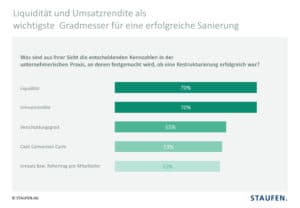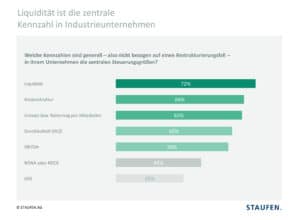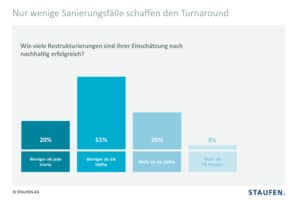
Not even half of all company or division restructuring is sustainably successful. 71 percent of the board members and managers of medium-sized industrial companies in Germany are convinced of this. One in five top managers even forecasts a success rate of less than 25 percent. These are the results of the “2018 Restructuring” study. Business consultancy Staufen surveyed 244 board members and managing directors of medium-sized industrial companies.
According to the company’s leaders, the key indicators of liquidity and return on sales show whether restructuring is successful. They are also convinced that liquidity is one of the key performance indicators in companies, followed by cost structure, revenue or gross profit per employee, lead time and EBITDA. Almost all executives say that they make very consistent decisions in their company based on these key figures.
“But in doing so, they are looking exclusively into the past – a view that is decidedly short-sighted in times of major geopolitical upheavals and digital change,” says Andreas Sticher, Restructuring Expert at the business consultancy Staufen. “The pace of change can no longer be maintained, but is rather growing at an exponential rate.”
The Staufen partner recommends that companies take a preventive approach to potential crises. Restructuring should not only be discussed when a company is already in a crisis situation but also in good times. “Many companies did not take this to heart during the past good years. This could come back to haunt them in future financing talks with banks,” says the restructuring expert.
After the boom, dark clouds are beginning to appear on the economic horizon: Experts are forecasting falling growth rates for the German and global economy, and a severe crisis cannot be ruled out. “So it is high time for industry to prepare for such a development. This is because the most common reason for industrial companies to undergo restructuring in the past was an economic slump (33 percent) followed by intensified price wars (29 percent). However, many crisis triggers are also homemade. These include a lack of market or customer orientation (26 percent), management errors (25 percent), sales problems (22 percent) and strategic mistakes (22 percent).
“Companies need to ask themselves two questions. Firstly, how can existing success be secured? Secondly, how can digital change be managed with new business models and structures at the same time,” says Andreas Sticher. “What we need is predictive restructuring. To achieve this, companies must think more broadly and always in combination with operational excellence, digitization and leadership. This is the only way to ensure sustainability in the transformation process. Leadership and corporate cultures that promote the ability and willingness to change at all levels are also vital.”




